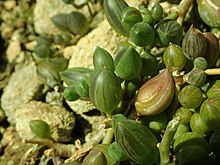
Senecio is a genus of flowering plants in the daisy family (Asteraceae) that includes ragworts and groundsels.

The Aizoaceae, or fig-marigold family, is a large family of dicotyledonous flowering plants containing 135 genera and about 1800 species. They are commonly known as ice plants or carpet weeds. They are often called vygies in South Africa and New Zealand. Highly succulent species that resemble stones are sometimes called mesembs.

Ceropegia woodii is a flowering plant in the dogbane family Apocynaceae, native to South Africa, Eswatini and Zimbabwe. It is sometimes treated as a subspecies of the related Ceropegia linearis, as C. linearis subsp. woodii. Common names include chain of hearts, collar of hearts, string of hearts, rosary vine, hearts-on-a-string, and sweetheart vine.
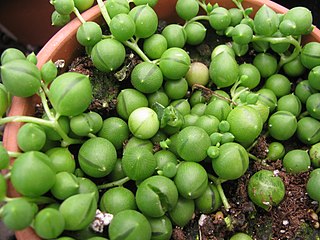
Curio rowleyanus, syn. Senecio rowleyanus, is a flowering plant in the daisy family Asteraceae. It is a creeping, perennial, succulent vine native to the drier parts of southwest Africa. In its natural environment its stems trail on the ground, rooting where they touch and form dense mats. It often avoids direct sunlight by growing in the shade of other plants and rocks. It is commonly known as string-of-pearls or string-of-beads.

Hoodia juttae is a species of plant in the family Apocynaceae. It is endemic to Namibia. Its natural habitats are rocky areas and cold desert. H. juttae is found around the Little and Great Karas mountains. It is threatened by collection. The plant was discovered by Jutta Dinter, the wife of botanist, Kurt Dinter in 1913. The scientific name refers to Jutta.

Hoodia ruschii is a species of stem succulent plant in the family Apocynaceae. It is endemic to Namibia. Its natural habitats are rocky areas and cold desert.
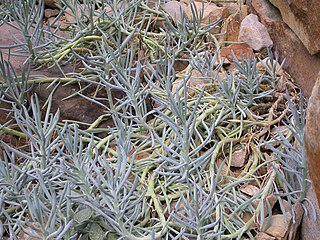
Curio ficoides, syn. Senecio ficoides, also known as skyscraper Senecio and Mount Everest Senecio, is a species of succulent plant, in the genus Curio (Asteraceae), indigenous to South Africa.

Curio archeri, syn. Senecio toxotis is a species of succulent plant in the family Asteraceaethat is indigenous to the south-western Cape, South Africa.
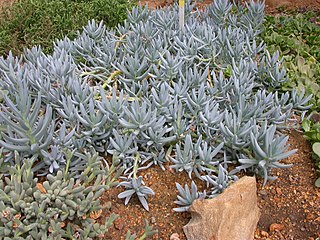
Curio repens, syn. Senecio serpens, is a species of the genus Curio in the Asteraceae family. A succulent endemic to the Western Cape province of South Africa, it is typically found growing from crevices in rocky sandstone slopes. Commonly named blue chalksticks, it is used as an ornamental plant.

AnacampserosL. is a genus comprising about a hundred species of small perennial succulent plants native to Southern Africa, Ethiopia and Latin America. The botanical name Anacampseros is an ancient one for herbs supposed to restore lost love.
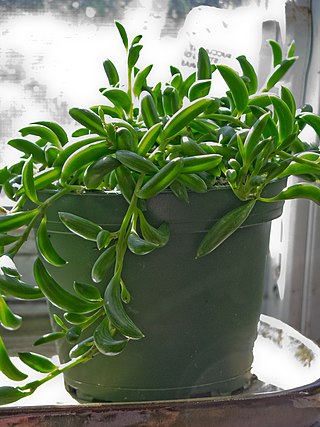
Curio radicans, syn. Senecio radicans, is a succulent houseplant that is native to South Africa. A member of the family Asteraceae, the asters, this species is closely related to the common string of pearls and Curio hallianus. It has multiple tendrils of glossy, banana-shaped foliage. It is commonly known as string of bananas or fishhook senecio.

Lithops francisci, commonly known as one of the living stones or pebble plants, is in the family Aizoaceae. It is endemic to the arid desert environments of Namibia. It is a succulent with a natural habitat in rocky areas. L. francisci was assessed by Nicholas Edward Brown in 1925. It is one of the Lithops plants and shares the characteristic bi-leaf head pattern separated by a deep fissure, the bottom of which houses and protects the stunted stem.
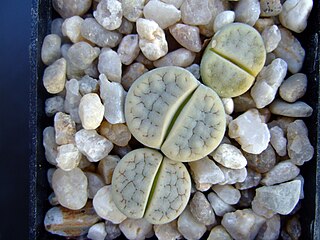
Lithops gracilidelineata is a species of the genus Lithops under the family Aizoaceae. The succulent plant lives in the southern region of Africa, and receives its name from the Latin words gracili and linea, combining to form the translation of "fine lined."

Curio × peregrinus, also known as dolphin necklace, flying dolphins, string of dolphins, dolphin plant or Senecio hippogriff, is a succulent nothospecies of Curio in the family Asteraceae. It is often called, incorrectly, Senecio peregrinus, but that name was previously given, by Grisebach in 1879, to a different species from South America. The name Curio × peregrinus was published in 1999, based on the earlier name Kleinia peregrina; however, this name was not validly published. The plant is a hybrid between Curio rowleyanus and Curio articulatus.

Curio is a genus of flowering plant in the family Asteraceae. Plants in the genus are evergreen succulents with long, striated leaves and discoid flower heads lacking ray florets.
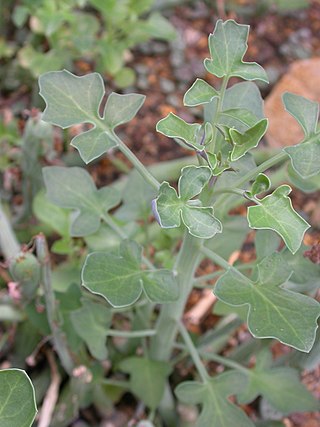
Curio articulatus, syn. Senecio articulatus, which is also known as candle plant, pickle plant and hot dog cactus, is a deciduous succulent plant that is native to South Africa.
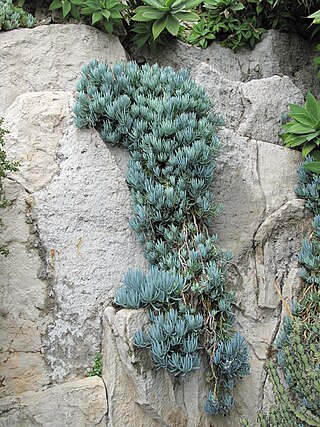
Curio talinoides, syn. Senecio mandraliscae, also known as blue straws, blue chalksticks, dassieharpuis, or narrow-leaf chalk sticks, is a succulent plant of the family Asteraceae that is native to South Africa. The origin of this plant is dubious and it may be a hybrid.
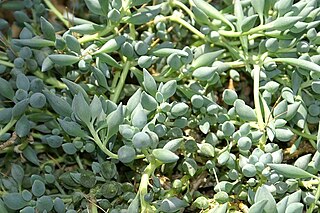
Curio citriformis, syn. Senecio citriformisis, also known as string of tears, is a trailing succulent plant in the family Asteraceae native to South Africa that grows in rocky outcrops in clay soils.

Curio hallianus, syn. Senecio hallianus, is a creeping succulent plant in the daisy family Asteraceae that is native to South Africa. It is also known as chain of blue beans or string of beans.
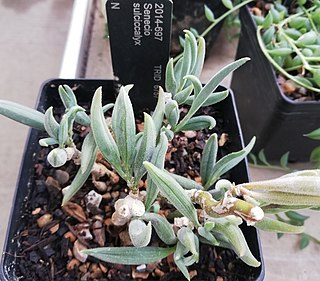
Curio sulcicalyx is a small succulent plant in the family Asteraceae that is native to South Africa and Namibia.
